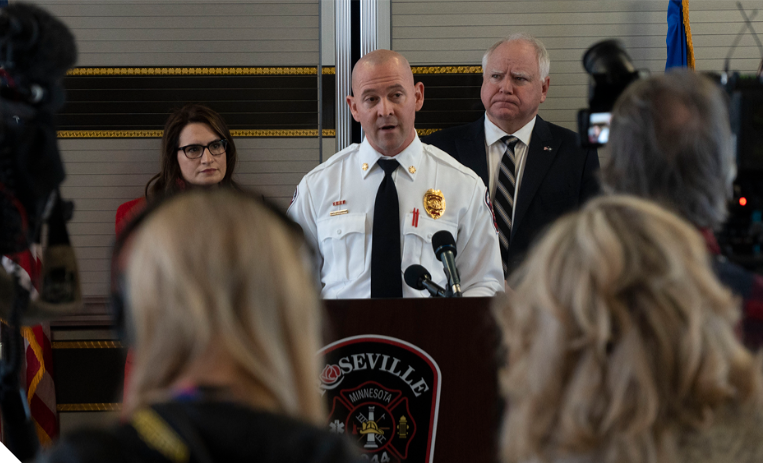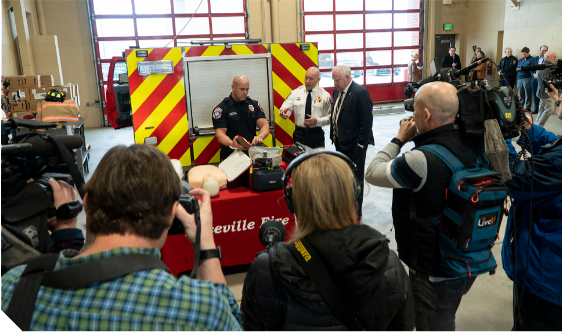Cultivating and Managing Relationships With Journalists

By Corey Yunke
Working with the media can be one of the most intimidating aspects of holding public office or working in local government.
You are relying on a group outside of your organization to summarize your hard work and deliver your carefully crafted messages. If a reporter misses the nuance or just gets it wrong, it can feel like there’s little opportunity to set the record straight.
The City of Roseville’s newly re-envisioned Community Relations Team is sharing its strategies to build and improve relationships with members of the media and use the industry’s powerful bullhorn to promote its city’s good work.
Here are six strategies to employ when working with the media.
1. Make the first move. Former Star Tribune reporter Shannon Prather remembers her first conversation with Roseville Community Relations Manager Corey Yunke because it was a bit unusual.
“He called me. That never happens!” Prather said. “As a reporter for two decades, I was used to making the first overture when it came to meeting sources on my beat.”
The two met at a local coffee shop and chatted. The whole meeting took about an hour, but it laid the foundation for a productive partnership that yielded several positive cover stories, including one highlighting the city’s new partnership with Twin Cities Habitat for Humanity.
“That first meeting just started our relationship on such a positive note,” said Prather, who joined the City of Roseville’s Community Relations Team in February. “I felt as though Roseville was doing innovative things and was eager to share them with the public.”
2. Use your in-house experts. Roseville employs a cadre of experts who can speak knowledgeably about everything from trends in urban planning, to community policing best practices, to sustainability. These experts play a critical role in the city’s communications strategy.
When reporters seek a comment, Roseville doesn’t default to a generic statement attributed to “the city” or rely solely on its spokesperson.
“We use our team to help connect, advise, and strategize our messaging. But whenever possible, we have our subject-matter experts speak with the credibility and authenticity that the public expects,” Yunke said. “We know our residents want to hear from their elected officials, our police and fire chief, parks director, and other city leaders.”
3. Keep it short and simple. Most television news reports are 30 seconds to two minutes long. Newspaper articles run between 400 and 800 words, and they typically include multiple sources. That means you need to boil down your message to a few sentences, Yunke said.
“I know it can be challenging to hone your message,” Yunke said. “But, the more you meander, the more latitude the reporter has to pick and choose your message, leaving you unsatisfied with the final report.”

4. Don’t ghost the media. The biggest mistake you can make with the media is to not return calls. It’s a missed opportunity to strengthen your organization’s brand when it’s a good news story. When it involves a more contentious subject, not calling back allows journalists to drop a “didn’t return a request for comment” in their report and then spend two minutes espousing the other side of an issue. It can also make your organization look defensive and unresponsive to your community.
“Don’t give reporters an easy out by ghosting. Return the call,” Prather said.
Even if your organization’s statement is as simple as, “We are looking into that,” you are responding and setting the table for future coverage.
5. Use social media to tell your stories. Reporters, editors, and producers scour Facebook, Twitter, and Instagram for leads. Make sure you are using social media to publish press releases, as well as to tell your good news stories.
On a slow news day, your city’s Facebook post on the city’s innovative pollinator garden or new affordable housing initiative can turn into a feature on the 6 p.m. news.
As smaller community newspapers continue to fold, residents are increasingly turning to their city’s website, newsletter, and social media to stay informed.
“Collectively, the City of Roseville has over 40,000 followers across our social media profiles with nearly 13,000 of those followers on the neighborhood app, Nextdoor,” said Roseville Community Relations Team member Ian Walesch. “We know our residents are eager for information about city programs and services. Social media is the quickest way to fill that information gap.”
6. Ask for a fact check. Most journalists are generalists who are expected to report on a wide variety of subject matter. It’s really challenging to master tax increment financing or the distinctions of your city’s new zoning code from a 10-minute interview. At the end of your interview, request a fact check before publication and provide an email or cellphone number so they may contact you.
“Journalists are not required to do fact checks, but I’ve found that reporters typically welcome the chance to review facts one last time before publication,” Yunke said. “This really helps to build trust and ultimately, yields a better product.”
Corey Yunke is community relations manager with the City of Roseville. His team includes former Star Tribune reporter Shannon Prather and Ian Walesch, who specializes in digital design and social media strategy.

